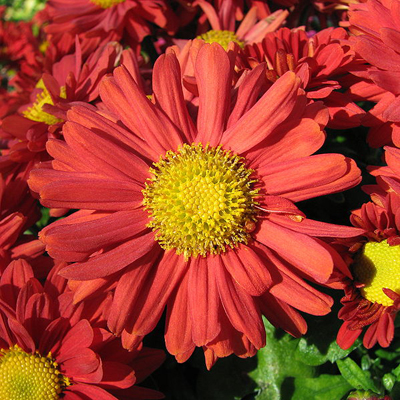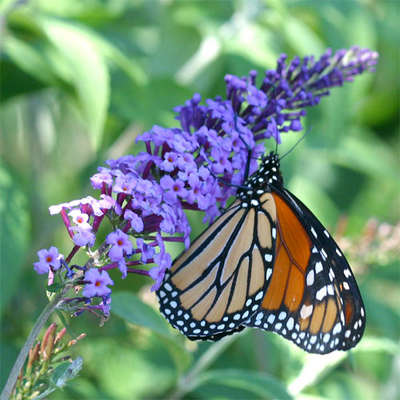|
|
Q&A
Ask a Master Gardener |
When should I divide my maiden grass "Gracillimus'?
There's an old saying among gardeners: Divide spring-flowering perennial plants in fall and fall-flowering perennials in spring. The same is true for Gracillimus, commonly called maiden grass.
Division is usually done when a plant has grown to considerable size and needs better spacing. It may also be needed to promote optimal health. If roots at the center of the plant have begun to die, they should be removed to make way for new roots and to eliminate the potential of diseases. Most ornamental grasses that bloom in the fall should be divided in the spring when there is time for roots to develop and grow.
After the first freeze, the foliage and seed heads of showy ornamental grasses can be left in place to extend the perennial garden's season as well as to provide shelter for birds through the winter.
I purchased a bag of bulbs, and the instructions say to place them in the refrigerator for six weeks before planting. Do I really need to do that in our area? I've never done it before and had great spring blooms!
The term "stratification" means the breaking of dormancy in seeds or bulbs. Most bulbs have simple stratification needs, either cold, warmth, moisture or some combination. Most bulbs purchased for planting in the fall will have been stratified by the growers. Our own natural freezing and thawing cycles likely will be sufficient to cause the bulbs to sprout in the spring. Still, it is always best to follow label directions carefully on packaging.

My mums have stopped blooming in my flower pots and I want to plant them in the garden. Can I divide them now before I plant them?
Chrysanthemums are best divided every two or three years in the spring. Even though dividing now after bloom would not disturb the formation of flower buds, the onset of cold weather and our first freeze could further stress the roots of recently divided plants.
My butterfly bushes are still in bloom. Should I continue dead-heading the flowers to promote continued blooming or prune them back for winter?
Butterfly bushes, or buddleias, produce beautiful blooms that attract hummingbirds and butterflies all summer and fall. It is a great idea to prolong blooms by dead-heading until first frost because, unlike roses that need to form hips to prepare for winter, most flowering perennials and annuals will bloom fine until dieback from cold. 
For pruning back the tall branches, it is best to wait until early spring, before new buds begin to form. This will prevent dieback of new growth. Buddleias, which can grow to 12 feet tall, can be pruned to one third of the bush or occasionally down to 8 inches from the ground. Leaving brown branches on most perennials during the winter provides some protection for the roots and crown from drying winds and cold temperatures. |
 |
4 Ways to Contact Us |
Email us at:
See our website at:
Call us at: 746-3701 from 9-4,
M-F
Visit us at 4116 East 15th Street, Gate 6 at the Fairgrounds
Whether you call or bring samples of plants to the office, trained Master Gardeners will answer your gardening questions with science based information. | |
|
|
|
|
|

| 15 Lawn and Garden Tips for Winter | |
Lawns
- This will be our last e-newsletter for several months, so we leave you with a good number of winter gardening tips. See you again on February 1st.
- Fall leaves may be mowed into all Oklahoma turf grasses - Bermuda as well as fescue. Shred them completely so no leaves remain visible. Mulching leaves into the lawn does not cause disease or thatch. See below for more information.
- November is the time to give your fescue lawn the last nitrogen fertilizer application of the year. Fescue is best fertilized equally in March, September and November, but never in summer. Use a soluble (quickly available) fertilizer high in nitrogen. Check the label on the bag for the proper amount to apply. Click here for a 12-month fescue lawn maintenance schedule.
- Continue to mow fescue as needed at 2 inches, and water during dry conditions.
- For a Bermuda lawn, don't fertilize until spring.
- November and December is a good time to spray 2,4-D type herbicides to control dandelions and other broadleaf weeds. Apply when the temperature is above 50 degrees.
Gardens
- After the first freeze, clean up the debris from your garden. Diseased materials should be bagged and put in the trash, not your compost pile. One of the best gardening habits you can cultivate is good sanitation.
- Clean and store garden tools. A light coating of oil will help prevent rust.
- Disconnect garden hoses before the first freeze. Drain and store in the garage or shed.
- Now is a good time to obtain a soil test to learn what type of amendments should be added to your garden. Click here for detailed instructions on how to gather a soil sample.
- Leftover garden seeds can be stored in an airtight container in the refrigerator or freezer until the next planting season. It's best to discard unused seeds after three years.
Trees, shrubs and flowers
- Mulch your perennials. This would be a good place to use mulched leaves. Wait until after the first hard freeze.
- Wait until late winter/early spring for routine pruning of your shrubs. Remove dead or diseased limbs anytime. To prevent blossom loss, prune spring flowering shrubs only after blooming is completed. Knock-Out roses, that prolific all-season bloomer, can be pruned back after March 15.
- Spring-blooming bulbs should be planted before Nov. 15.
- The trunks of newly planted trees should be wrapped with a commercial tape to prevent bark sunscald that develops with warming and freezing temperatures. Remove in spring.
- Mulch younger trees with two or three inches of mulch. Don't cover the base of the trunk, because it may lead to disease or insect problems. Remember, the pile of mulch should look like a donut, not a volcano.
|
 |
Mulch those fall leaves |
How should you handle all the leaves that will be left in your yard over the next few months? Rather than raking, bagging and throwing in the trash, there is a better way.
First, get the leaves out from under plants and shrubs and onto a grassy area. Use a rake or power blower to do this. Put your lawn mower in the "mulching" mode, making sure the mowing height is above the grass level, then mulch your leaves. When done, attach your leaf catcher and make one more pass over your lawn. You now have a compact collection of mulched leaves to put on your garden, shrubs or your compost pile.

An even easier method is to mulch the leaves right into your lawn. Blow or rake the leaves onto your grass as mentioned above. Then mulch them into the lawn. This might take several passes in several directions. Scientific studies have shown that when leaves are mulched into the turf, there are fewer weeds, increased water conservation, added fertility and most importantly, it adds organic content to the soil.
The bottom line is that if you mulch your leaves into the turf grass, garden beds or compost pile, both you and the city landfill are better for it. Click here for more information about leaf composting. |
 | Need more information? Click on any of the links below
|
How to Take a Soil Test
How to collect a good sample of soil from your lawn or garden and get it tested at the OSU lab.
|
 |
Forward to a friend |
| If you would like to forward this issue of our eNewsletter to a friend, just click the "forward email" at the bottom of the page. | |
|
| |
Oklahoma State University, in compliance with Title VI and VII of the Civil Rights Act of 1964, Executive Order 11246 as amended, Title IX of the Education Amendments of 1972, Americans with Disabilities Act of 1990, and other federal laws and regulations, does not discriminate on the basis of race, color, national origin, gender, age, religion, disability, or status as a veteran in any of its policies, practices or procedures. This includes but is not limited to admissions, employment, financial aid, and educational services. |
|
|
|
|
|